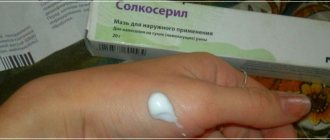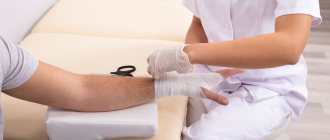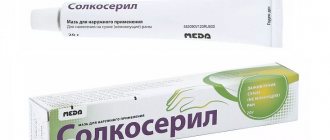Composition and release form
Miramistin is a 0.01% solution of eye drops, colorless, transparent, and may foam when shaken. Each milliliter contains:
- Active ingredient: benzyldimethyl-myristoylamino-propylammonium chloride monohydrate – 0.1 mg
- Additional components: purified water.
Packaging: white polyethylene bottles of 50, 100, 200 ml in cardboard packs.
The bottle can be equipped with an applicator with a screw cap, as well as a sprayer or a spray pump to create an aerosol (however, this form is practically not used in ophthalmology). What cardboard packaging might look like is shown in the photo on the page. In some cases, the design may differ from what is shown.
How to cure tooth decay without a dentist
It is believed that it is impossible to cure a tooth affected by caries without visiting a dentist. But only if it is not caries at the chalk spot stage - this is the initial stage of caries, when calcium is washed out of the tooth enamel. At this moment, the tooth is most susceptible to attack by cariogenic bacteria. But the damage can still be stopped without visiting the dentist.
For example, using remineralizing gels. They contain all the necessary minerals that fill the washed areas: for example, in Tooth Mousse, casein performs this function. This way the tooth regains its original appearance and receives additional protection from carious formations.
Even if a child, at first glance, does not have caries, the gel can be used for prevention.
Gel for strengthening teeth ROCS (ROCS) Medical Minerals with tuber flavor…
Gel for strengthening teeth ROCS (ROCS) Medical Minerals with fruit flavor…
Tooth gel GC Tooth Mousse Strawberry
Tooth gel GC Tooth Mousse Multifruit
Pharmacological properties
Miramistin solution is an antiseptic drug with a bactericidal effect. Shows activity against gram-positive bacteria and viruses, including herpes viruses and human immunodeficiency viruses. It also has an antifungal effect. It is also effective against antibiotic-resistant bacteria and sexually transmitted pathogens.
Miramistin prevents infection of burns and wounds. Stimulates regeneration processes. Activates local protective reactions, due to the improvement of the absorption and digestive functions of phagocytes, potentiates the activity of the monocyte-macrophage system. It has hyperosmolar activity, which allows it to stop wound and perifocal inflammation, absorbs purulent exudates, and promotes the formation of a dry scab. The use of the drug does not damage granulations, does not suppress marginal epithelization, and does not affect viable skin cells. The drug stimulates the resorption of dark spots on the cornea, prevents the formation of cataracts, prevents perforation and the development of ulcerative-necrotic and purulent complications, including when used in the treatment of burns and eye injuries.
When applied topically, it does not cause irritation or allergic reactions. The medicine, including in the form of eye drops, does not have embryotoxicity, carcinogenic or mutagenic properties: the antiseptic is harmless to the body when applied topically. It is not absorbed through the skin and mucous membranes, and practically does not enter the systemic circulation.
Dr. Komarovsky: Children suffer from acute respiratory infections more often than adults - this is the norm, this is the law of life
In the specialized medical literature, the abbreviation BBD is often found. The standard decoding is children who are often ill. Sometimes the expression “frequently and for a long time ill children” is used.
Maturation of the immune system
In clinics, children who are often ill are kept under special dispensary care. But let's look at the situation objectively: is it worth worrying or are these statistics arbitrary? Adults lead a less healthy lifestyle than their children, but suffer from acute respiratory infections much less often. Although our mothers told each of us that in childhood we got sick 10 times a year, and then less and less. This is a law of life: children get sick with acute respiratory infections more often than adults - this is the norm.
A child is born with an immature immune system; it takes time to develop. Babies are surrounded by many people, each of whom is a carrier of a huge number of viruses and bacteria. The child will have to develop immunity to these microorganisms. But nature has done everything to ensure that frequent childhood illnesses are not dangerous. Children's bodies easily cope with acute respiratory infections. And every encounter with the virus is training, formation, and improvement of immunity. How will this all end? A frequently ill child will become an adult and healthy parent.
Tolerate or treat?
No matter how much I urge parents to treat childhood illnesses calmly, not everyone succeeds. Sometimes a mother literally cannot count how many times a year the child has had acute respiratory infections - they simply never end. But parents should know that congenital disorders of the immune system, so-called primary immunodeficiencies, are very rare. They manifest themselves not just as frequent ARVIs, but as severe ARVIs with dangerous bacterial complications that are difficult to treat. Congenital immunodeficiency is a fatal condition and has nothing to do with a two-month runny nose. On the other hand, frequent acute respiratory infections may be a consequence of secondary immunodeficiency - that is, the child was born healthy, but some external factors interfere with the normal development of his immunity.
The main conclusion: if a child who is normal from birth does not recover from illness, it means that he has a conflict with the environment. There are two options for help: try to reconcile the child with the environment with the help of medications, or try to change the environment so that the child is satisfied with it.
Environment
The formation and functioning of a child’s immune system is determined by his lifestyle. If a child often suffers from acute respiratory infections, no pills will solve this problem. Eliminate conflict with the environment, change your lifestyle.
Housing. Organize a child's room where there is no accumulation of dust, everything is subject to wet cleaning and regular ventilation. Night temperature – 18°C, humidity – 50–70%. Soft toys are accumulators of dust, allergens and microorganisms.
Nutrition. Never force a child to eat. It is ideal to feed when he begs for food. Stop snacking, don’t overuse foreign foods, and don’t diversify your diet too much. For sweets - dried fruits, not chocolates.
Drink. Optional: mineral water, compotes, fruit drinks, fruit tea. The temperature of the drinks is room temperature.
Cloth. A sufficient minimum, since sweating causes illness more often than hypothermia. The child should not be wearing more items of clothing than the parents.
Walks. Daily, active, preferably before bedtime.
Sport. Outdoor activities are ideal, rather than in confined spaces. Swimming in a pool is not appropriate for CBI.
In summer. The child should take a break from contact with people, from city air, chlorinated water and household chemicals. Holidays “at the seas” have nothing to do with improving your health, since most of the harmful factors remain, plus public catering and worse living conditions. An ideal vacation for a private person: a village, an inflatable pool with well water, a pile of sand nearby, in shorts and barefoot. A dirty naked child who jumps from water to sand, begs for food and breathes fresh air, restores immunity in 3-4 weeks.
Prevention of acute respiratory infections. Frequent illnesses are caused not by cold, but by viruses. We must avoid unnecessary contact with people, wash our hands, maintain local immunity, and vaccinate all family members against the flu.
Treatment of ARVI
Treating ARVI does not mean giving medications, but means creating conditions so that the child’s body can cope with the virus as quickly as possible and with minimal losses. It is necessary to ensure optimal temperature and humidity, dress warmly, do not overfeed, and actively water. Saline drops in the nose and antipyretic medicine if necessary are enough. Any active treatment prevents the formation of immunity. The drug should be used only when it is clearly impossible to do without it. This is especially true for antibacterial therapy.
Actions after recovery
It is important to remember: improvement in condition and normalization of temperature does not indicate that immunity has been restored. The next day after the child’s condition improves, he goes to a group where he encounters a new virus, and a new disease will begin in a weakened body. It will be more severe than the previous one and will require the use of medications.
When it gets better, you need to live a normal life for another week - walks, “working up” your appetite, healthy sleep, restoration of the mucous membranes. Antibodies to the virus are produced no earlier than the fifth day of illness. Therefore, you can resume visiting children’s groups no earlier than the sixth day after the onset of ARVI, regardless of its severity.
There are no non-kindergarten children
When the phrase “I wasn’t sick until I was three” is said, it means we have an absolutely normal child. We went to kindergarten, the environment changed - illnesses began. We must acknowledge the fact that it is impossible to start actively communicating with children and not get sick. Constant illness means either you are in a hurry to return to your children after illness, or something is fundamentally wrong in the kindergarten itself.
Even very frequent acute respiratory infections with proper treatment do not affect the child’s health.
But if every sneeze is a reason to prescribe a dozen syrups, tablets and antibiotics, a reason for a thorough examination and consultation of a dozen specialists, such acute respiratory infections are a clear and obvious evil. If a child suffers from acute respiratory infections often, even very often, but recovers not with the help of medications, but naturally, then let him be sick, let him go to kindergarten. Published: September 26, 2016
Indications for use
- Conjunctivitis, including chronic.
- Blepharoconjunctivitis.
- Traumatic keratitis.
- Eye burns, corneal erosions.
- Ophthalmochlamydia.
- Keratouveitis and corneal ulcers.
- Purulent-inflammatory processes in the anterior segment of the eye.
- Preoperative preparation, conditions after eye surgery.
In ophthalmology, Miramistin is used in complex treatment of the consequences of thermal and chemical burns and injuries to the visual organs in adults and children over 3 years old, as well as for infectious and inflammatory diseases. The drug can be used in combination with other antiseptic and antibacterial agents as prescribed by a doctor.
References
- Bulatov, V.P. Clinical pharmacology in pediatrics V.P. Bulatov, T.P. Makarova, I.N. Cherezova. M.: Phoenix, 2006.
- Vinnik Yu. S., Kochetova L. V., Karlova E. A., Teplyakova O. V. Asepsis and antiseptics; Phoenix, Publishing projects Moscow, 2007.
- Garden, A.S. Pediatric and adolescent gynecology A.S. Garden. M.: Medicine, 2013.
- Clinical pharmacology / ed. V.G. Kukesa. 6th ed., rev. and additional M.: GEOTAR-Media, 2022.
- Likhachev, A.G. Diseases of the ear, nose and throat A.G. Likhachev. M.: Medicine, 2022.
- Palchun, V.T. Otorhinolaryngology V.T. Palchun. M.: GEOTAR-Media, 2014.
- Frolenko S.I. Asepsis and antiseptics. Handbook for nurses; Phoenix Moscow, 2001.
- Kharkevich D.A. Pharmacology. M. Medicine, 1999
Directions for use and doses
The standard dosage of Miramistin solution is 2 drops conjunctivally 4-5 times daily. The frequency and volume of use in a particular case may differ from the standard ones, since in each situation the format of use is determined by the attending physician. The course of treatment can last from 3 to 10 days, which is determined by the doctor and depends on the severity of the pathology. It is not recommended to use a package form with a spray or a spray pump and spray the medicine into the affected area: this makes it difficult to calculate the dosage. It is recommended to use a package with an applicator to adjust the dose more accurately.
In order to prevent surgical infections, Miramistin solution is prescribed two days before surgery, 1-2 drops three times a day, and another 10-15 days in the postoperative period (at the same dosage) in combination with other drugs that suppress pathological activity. In some cases, the drug is dripped in a hospital setting during pre- and postoperative hospitalization.
Reviews for Miramistin
An excellent remedy for preventing sexually transmitted infections. Once my partner and I had a condom break. At first I panicked, because we had known each other not so long ago, and then I started looking on the Internet for what to do in this case... I found an article about Miramistin... It turned out to be in a nearby pharmacy and we used it.
Elena
I have chronic tonsillitis, my throat often hurts and Miramistin helps me well. The spray form is very convenient, so treating the throat with it is very easy. I spray it for a few days and everything goes away. Excellent tool!
Tatiana
I work in the garden and garage and sometimes I hurt my hand. I wash the wound with miramistin and apply a plaster. After several treatments everything heals quickly. The drug has a good antiseptic effect.
Sergey
Contraindications
- Individual hypersensitivity.
- Pregnancy, lactation.
- Children under 3 years old.
Information on the use of the drug during pregnancy and lactation is not provided, which does not allow us to predict whether Miramistin will have any effect on the fetus. If indicated, the use of the drug may be justified if the potential benefit to the mother outweighs the possible risk to the fetus. In this case, the drug is prescribed by a doctor. Since Miramistin is practically not absorbed and does not enter the bloodstream, the risk of negative effects on the fetus is minimal. However, due to the lack of any reliable data and studies on the use of Miramistin in pregnant women, it is not recommended to instill the solution without a doctor’s prescription.
special instructions
During treatment with Miramistin solution, it is better to refrain from wearing any types of contact lenses. It is recommended to use other methods of vision correction, since wearing contact lenses for inflammatory eye diseases can complicate treatment and lead to negative consequences. If for some reason the use of alternative methods of correction is impossible, the lenses must be removed before using the drug and put on 15 minutes after instillation.
After instillation of Miramistin solution, you should not drive or engage in potentially dangerous activities for 30 minutes.
The drug is intended for external use only. Ingestion of the medicine, as a rule, does not cause serious consequences, but can lead to nausea and the development of individual allergic reactions. In case of accidental ingestion of the product, especially by young children, it is recommended to perform gastric lavage and use enterosorbents (for example, activated carbon) according to the instructions. If any negative reactions occur, you should consult a doctor as soon as possible.
Store Miramistin solution at a temperature not exceeding +25° C. It is recommended to keep the drug in a place inaccessible to young children.
Shelf life – 3 years. Do not use after the stated expiration date.
What should the first brush be?
Dentists recommend switching to brushing with a toothbrush when baby teeth are at least halfway through. Your first toothbrush should have a compact head and synthetic bristles. In addition to the usual toothbrush, you can use a silicone finger brush: it massages the gums and relieves itching.
4 principles for choosing your first toothbrush:
- The head of the brush should be small and cover two teeth, no more. It will be very difficult to thoroughly remove plaque with a brush with a large head due to its clumsiness.
- The brush head should have silicone pads to make cleaning safe. For babies under one year old, a protective silicone ring (limiter) will not be superfluous.
- The bristles should be soft, thick and short.
- The handle of the brush should be comfortable for both the child and the parents.
From the age of 1 year, it is important to motivate children and fuel their interest in the cleaning process. Research has shown that using electric toothbrushes can be a way to build motivation. In addition, switching to an electric device improves oral hygiene compared to a manual brush: the amount of cariogenic microflora in saliva is reduced, and the risk of developing caries is reduced.
An electric toothbrush at an early age will allow the child to get used to the vibrations in the mouth, and it will be more convenient for parents to reach the distant teeth.
3 principles for choosing your first electric toothbrush:
- For children under 5 years old, it is recommended to choose models with extra soft or soft bristles.
- If the first electric brush has a bright design depicting fairy tale or cartoon characters, the child will form a pleasant association with brushing his teeth.
- The size of the brush head should not exceed 2 cm, and the handle should be rubberized. This way, the child will gradually begin to pick up the brush on his own, and the small head will allow him to brush his teeth more thoroughly.
CURAPROX Curakid Baby (0 to 4 years)
CS Medica CS-561 Kids (from 1 to 5 years) Yellow
Mega Ten Kids Sonic Kitten
Hapica Baby DBB-1Y (from 1 to 6 years)









